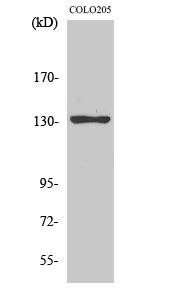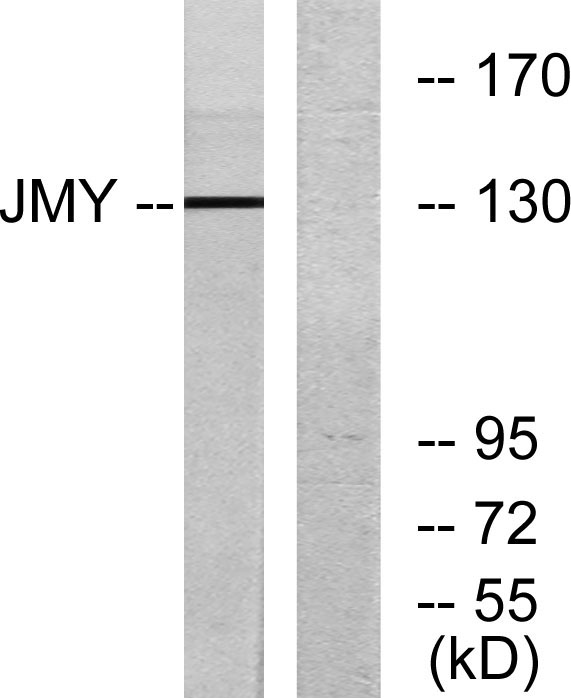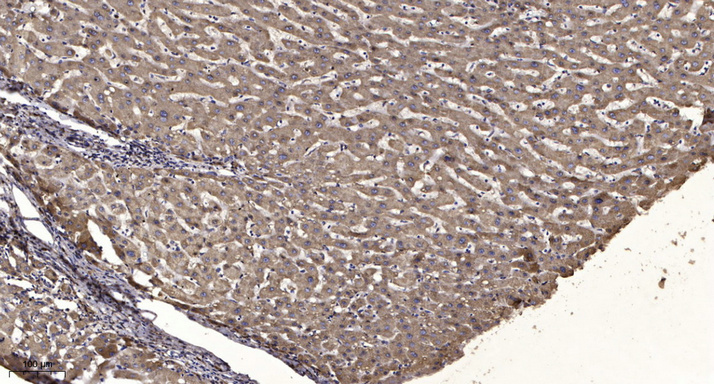JMY Polyclonal Antibody
- Catalog No.:YT2438
- Applications:WB;ELISA;IHC
- Reactivity:Human;Mouse
- Target:
- JMY
- Gene Name:
- JMY
- Protein Name:
- Junction-mediating and -regulatory protein
- Human Gene Id:
- 133746
- Human Swiss Prot No:
- Q8N9B5
- Mouse Gene Id:
- 57748
- Mouse Swiss Prot No:
- Q9QXM1
- Immunogen:
- The antiserum was produced against synthesized peptide derived from human JMY. AA range:931-980
- Specificity:
- JMY Polyclonal Antibody detects endogenous levels of JMY protein.
- Formulation:
- Liquid in PBS containing 50% glycerol, 0.5% BSA and 0.02% sodium azide.
- Source:
- Polyclonal, Rabbit,IgG
- Dilution:
- WB 1:500-2000;IHC 1:50-300; ELISA 2000-20000
- Purification:
- The antibody was affinity-purified from rabbit antiserum by affinity-chromatography using epitope-specific immunogen.
- Concentration:
- 1 mg/ml
- Storage Stability:
- -15°C to -25°C/1 year(Do not lower than -25°C)
- Other Name:
- JMY;Junction-mediating and -regulatory protein
- Observed Band(KD):
- 130kD
- Background:
- function:Cofactor that increases p53/TP53 response via its interaction with p300/EP300. Increases p53/TP53-dependent transcription and apoptosis, suggesting an important role in p53/TP53 stress response such as DNA damage.,induction:By E2F.,PTM:Ubiquitinated by MDM2, leading to its subsequent degradation by the proteasome. In case of DNA damage, the interaction with MDM2 is altered, preventing degradation and allowing interaction with p300/EP300 and its function in p53/TP53 stress response.,similarity:Contains 1 WH2 domain.,subunit:Interacts with p300/EP300, the complex being recruited to activated p53/TP53. Interacts with TTC5.,
- Function:
- function:Cofactor that increases p53/TP53 response via its interaction with p300/EP300. Increases p53/TP53-dependent transcription and apoptosis, suggesting an important role in p53/TP53 stress response such as DNA damage.,induction:By E2F.,PTM:Ubiquitinated by MDM2, leading to its subsequent degradation by the proteasome. In case of DNA damage, the interaction with MDM2 is altered, preventing degradation and allowing interaction with p300/EP300 and its function in p53/TP53 stress response.,similarity:Contains 1 WH2 domain.,subunit:Interacts with p300/EP300, the complex being recruited to activated p53/TP53. Interacts with TTC5.,
- Subcellular Location:
- Nucleus . Cytoplasmic vesicle . Cytoplasm, cytoskeleton . Endomembrane system; Lipid-anchor. Cytoplasmic vesicle, autophagosome membrane . Localizes to the nucleus in most cell types. Accumulates in nucleus under DNA damage conditions, increasing p53/TP53 transcription response and reducing its influence on cell motility (By similarity). In primary neutrophils, it colocalizes with actin filaments at the leading edge and is excluded from the nucleus. Localization correlates with motility, because it moves from the nucleus to the cytoplasmic compartment when cells are differentiated from nonmotile cells into highly motile neutrophil-like cells. Localizes to cytoplasmic vesicles which associate with actin filament and autophagosomal membranes upon starvation-induced autophagy (PubMed:30420355
- Expression:
- Brain,Substantia nigra,
- June 19-2018
- WESTERN IMMUNOBLOTTING PROTOCOL
- June 19-2018
- IMMUNOHISTOCHEMISTRY-PARAFFIN PROTOCOL
- June 19-2018
- IMMUNOFLUORESCENCE PROTOCOL
- September 08-2020
- FLOW-CYTOMEYRT-PROTOCOL
- May 20-2022
- Cell-Based ELISA│解您多样本WB检测之困扰
- July 13-2018
- CELL-BASED-ELISA-PROTOCOL-FOR-ACETYL-PROTEIN
- July 13-2018
- CELL-BASED-ELISA-PROTOCOL-FOR-PHOSPHO-PROTEIN
- July 13-2018
- Antibody-FAQs
- Products Images

- Western Blot analysis of various cells using JMY Polyclonal Antibody

- Western blot analysis of lysates from COLO cells, using JMY Antibody. The lane on the right is blocked with the synthesized peptide.

- Immunohistochemical analysis of paraffin-embedded human liver cancer. 1, Antibody was diluted at 1:200(4° overnight). 2, Tris-EDTA,pH9.0 was used for antigen retrieval. 3,Secondary antibody was diluted at 1:200(room temperature, 45min).



